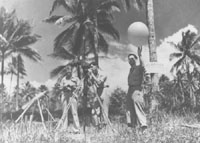Federation came to Australia in the middle of a long and terrible drought. The weather was much on the minds of determined nation builders. If Australia was to take full possession of the continent, then the cruelties of its climate would have to be conquered. Meteorology, it was hoped, would help the new nation to fulfill its destiny.
Meteorology appealed as a 'practical science'. By coordinating observations and issuing forecasts, the Bureau could save crops, it could even save lives. But meteorologists also sought to extend our knowledge of climate, and to refine forecasting techniques. Research underpinned meteorology's 'practical' value.
The Pacific War severely tested Australia's meteorological resources. Control of the Bureau passed to the RAAF, as many of its staff were posted to the front lines. Accurate forecasts were essential for aircraft and operational planning, but the tropical climate forced changes to established techniques. Both theory and practice evolved as meteorology was called to the nation's defence.
- Littleton Groom, Minister for Home Affairs, 1906

Pilot balloon ascent at Milne Bay, 1944. AWM Neg. no. 044684 (see 'The Story of the RAAF Meteorological Service')
'Weather forecasting is of vital concern to rural industries. It also becomes a matter of possible life and death when the reliance placed on it by commercial air services is considered.'
- Sydney Morning Herald, 14 June 1950
Article links
- Some of the links between meteorology and ideas of nationhood are explored in 'A Climate for a Nation'
- A general history of the Bureau's research effort is provided by 'Stormy Weather'
- Various postwar research activities are described in 'A Very Special Family'
- General histories of the Bureau's role in WW2 are provided by 'The Story of the RAAF Meteorological Service' and 'War History of the Australian Meteorological Service'
- First-hand accounts of the Bureau's war work are included in 'Some Recollections of Service in the Commonwealth Bureau of Meteorology', 'A Glimpse of the RAAF Meteorological Service', and 'Four Years in the RAAF Meteorological Service'
|
<< BACK | HOME | ARTICLES | INDEX | NEXT >> |
Background image: The first weather map issued by the Commonwealth Bureau of Meteorology, Age, 2 January 1902.
Design & content: Tim Sherratt (tim@discontents.com.au)
Published by the Australian Science and Technology Heritage Centre, August 2001
http://www.austehc.unimelb.edu.au/fam/practical.html